Origin Genesis Review: Triple Titan Terror
by Ryan Smith on April 23, 2013 9:00 AM ESTApplication and Futuremark Performance
Though our Genesis system is primarily intended for gaming, with gaming being such a resource-intensive hobby it tends to follow that the Genesis is also an incredibly high performer at virtually everything else. The 4.9GHz SNB-E processor is as fast as they come right now, and with the triple Titans and RAID-0 SSDs backing it up, it’s clear there are very few computers that will come anywhere close to the Genesis.
As such our standard application and Futuremark benchmarks are here mostly because they’re obligatory. We simply haven’t reviewed any prior systems, even other SNB-E systems, that are as powerful as the Genesis. It takes the top spot in everything.
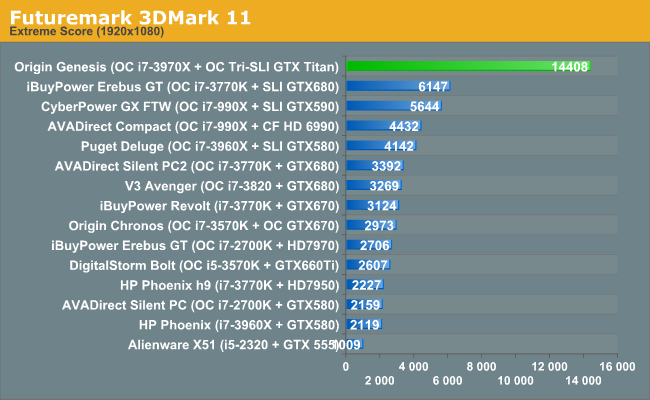

The Genesis more than doubles the 3DMark performance of the next-fastest system we’ve reviewed, an overclocked IVB + GTX 680 SLI configuration. Meanwhile the PCMark scores are much closer since most of the PCMark score is determined by CPU and storage performance rather than GPU performance, but thanks to the hefty overclock on its i7-3970X processor, the Genesis is still almost 700 points ahead of the next-closest system.
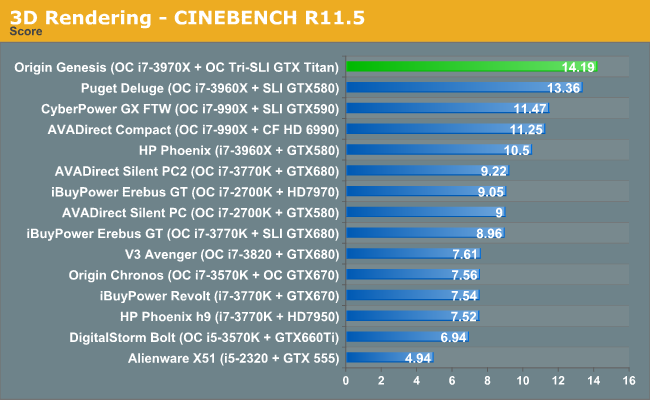
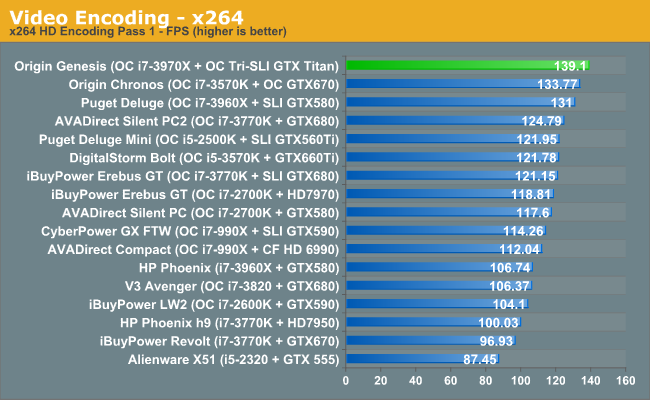
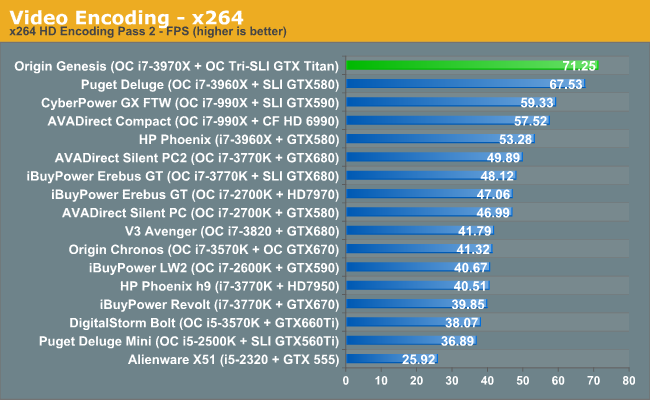
Diving into our CPU-dependent benchmarks, the story is much the same. Thanks to the CPU overclock, the 4.9GHz SNB-E processor means the Genesis pushes past even other SNB-E systems in both Cinebench and x264 encoding. At this point the Genesis is approaching the limit for what any kind of single-socket consumer system is going to be able to achieve.
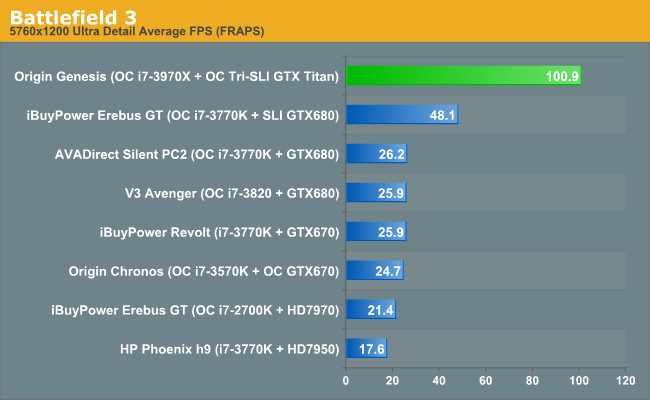
Finally, we’re throwing in one of our standard gaming benchmarks before going into tri-SLI Titan’s performance in-depth. Even at 5760x1200 with Ultra settings, Battlefield 3 is hard-pressed to keep 3 Titan cards occupied, with the Genesis delivering 100fps. 3D Surround BF3, anyone?










63 Comments
View All Comments
UltraTech79 - Tuesday, April 30, 2013 - link
All these idiots did was slap in the most expensive shit they could find. No real thought put into this. No thought put into how fucking loud this thing is or how usable. Its just one big circlejerk. I should charge them 100$ for wasting my time looking at it.Yoiu might think "yeah you say all that but if you got one youd be happy" Yeah, realistically Id be very happy, becuse Id sell the POS for 7-8k$ even if its individual parts and build a better PC for 2k and save the rest.
DPOverLord - Tuesday, June 25, 2013 - link
What are the thoughts on this driving a surround 27 / 30" 7680 x 1600 system? Are two titans enough or do you actually need 3?healingshoes - Friday, July 12, 2013 - link
something - ok a bunch of things - about this system build bother me... a lot.a lot a lot.
actually more than a lot a lot lol...
why use this "always on" power sucking money sink water cooling system, when the Titan SLI has fan control sensors so sensitive that it can respond to microscopic changes in environment?
and this cooling system, as the reviewer mentions, packs up all the free volume inside the casing, meaning the Titan's own cooling system is being completely sabotaged by origin's water cooling.... it doesnt have nearly enough internal volume of air to do what it's intended to do.
also, it's windows 7 not windows 8, so it has ZERO memristor pathing optimization, or green power consumption reductions, or auto fan control.
on top of all that, i have to look at that water cooling being stuffed in there, creating insufficient airflow for the titan's on board vents and fan, and what comes to mind is that the design of the air intakes and fan - look at the fan back casing on the titan... it;s an acoustic bouncer and amplifier. why would you AMPLIFY fan noise?
there can only be one reason for that. the shape of the rotor blades must be designed to combine the fan's low end air rumble with the air intake sound to create a harmonic which gives you SIGNAL CANCELLATION of your high end fan motor noise.
but without sufficient air volume inside the case, the morons turned signal cancellation into amplified motor noise because sound pitch gets altered, to a higher tone, and AMPLIFIED in a vacuum or partial vacuum. so instead of two layers of noise and two cancelled layers of noise, you end up with the 4 normal noise layers PLUS a harmonic which shouldnt be there.
and this reduced pressure from the fans not having enough air volume gives you a whole other problem in terms of creating more heat, BECAUSE WATER BOILS AT A LOWER TEMPERATURE AT LOWER PRESSURE!!!
I don't know what genius went and did this and for what reason, and I don't know how someone with this little basic knowledge of physics gets a job building high end computer systems, but I do know he sabotaged the performance tests. Badly.
To me, it seems like his water cooler was the noise and heat and power consumption problem, AND the 3rd card underperformance problem.